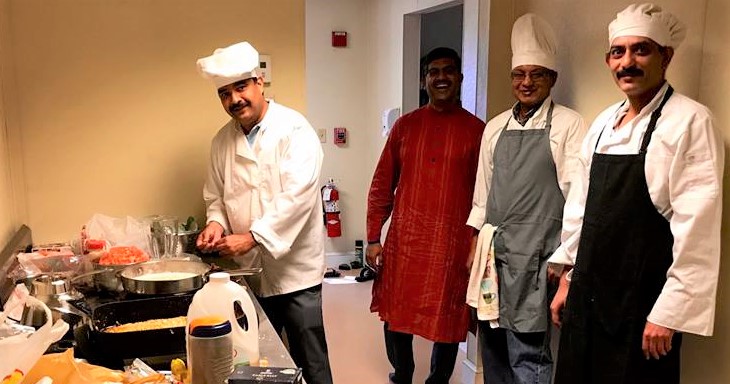Contribute
| Chinmaya Mission Boston In The Spotlight: The Tradition Of Annadaanam |
Dr. Vijayakumar Harohalli
04/29/2021
The Tradition of Annadaanam When I
visited the Golden Temple in Amritsar, India, it was early morning. The dining
hall where langar was served was already full. It was a huge
space. They said that it could seat 5000 people at one time. Hundreds of
volunteers were serving hot Rotis and dal with machine-like
precision. The devotees would receive the Rotis with folded hands with
absolute devotion. To them, the food served at the temple is a gift from God.
This tradition which has been in continuous existence since the 1400s is
revered by devotees from all walks of life. Emperors and beggars, men, women,
and children sit on the same floor to receive the prasad. This
enormous operation is almost entirely run by volunteers and the donations keep
coming in cash or kind. The sheer magnitude of the service is mind-boggling. On
any given day 50,000 meals are served and on special occasions, there might
even be 100,000 people. 11000 pounds of wheat, 3000 pounds of rice, and many
other food items are needed daily to sustain this service! This
tradition called Annadaanam is followed in many temples and religious
institutions in India for hundreds of years. And, Hindu temples built by the
Indian diaspora have lovingly replicated the same custom in their adopted
lands. The Chinmaya Maruti Center in Andover has an Annadaanam program
when Balavihar is in session. About 300 to 400 meals are served every Sunday. What is
the scriptural context behind this tradition? Food is
regarded as a divine gift from Vedic times. अनà¥à¤¨à¤‚
बà¥à¤°à¤¹à¥à¤®à¥‡à¤¤à¤¿ वà¥à¤¯à¤œà¤¾à¤¨à¤¾à¤¤à¥ (Annam brahmeti
vyajaanaat) declares the Taittiriya upanishad. It means food, Annam, is the
supreme lord, Brahman himself. Before
eating a meal, in Chinmaya Mission, we are taught to say a prayer. बà¥à¤°à¤¹à¥à¤®à¤¾à¤°à¥à¤ªà¤£à¤‚ बà¥à¤°à¤¹à¥à¤® हविः बà¥à¤°à¤¹à¥à¤®à¤¾à¤—à¥à¤¨à¥Œ बà¥à¤°à¤¹à¥à¤®à¤£à¤¾ हà¥à¤¤à¤®à¥à¥¤ बà¥à¤°à¤¹à¥à¤®à¥ˆà¤µ तेन गनà¥à¤¤à¤µà¥à¤¯à¤‚ बà¥à¤°à¤¹à¥à¤®à¤•à¤°à¥à¤® समाधिना। । It is a
verse from chapter 4 of the Bhagavadgita. The food we eat is Brahman himself.
And, Brahman himself resides in the body to help digest this food ( अहं वैशà¥à¤µà¤¾à¤¨à¤°à¥‹ à¤à¥‚तà¥à¤µà¤¾ पà¥à¤°à¤¾à¤£à¤¿à¤¨à¤¾à¤‚ देहमाशà¥à¤°à¤¿à¤¤à¤ƒ) and convert it into the energy we need to go about in
our daily lives. Therefore every human endeavor is an offering to God, a sacred Yajna.
In the third chapter of the Bhagavadgita this whole cycle of life is
described: अनà¥à¤¨à¤¾à¤¦à¥à¤à¤µà¤¨à¥à¤¤à¤¿ à¤à¥‚तानि परà¥à¤œà¤¨à¥à¤¯à¤¾à¤¤à¥ अनà¥à¤¨à¤¸à¤®à¥à¤à¤µà¤ƒà¥¤ यजà¥à¤žà¤¾à¤¦à¥à¤à¤µà¤¤à¤¿ परà¥à¤œà¤¨à¥à¤¯à¤ƒ यजà¥à¤žà¤ƒ करà¥à¤®à¤¸à¤®à¥à¤¦à¥à¤à¤µà¤ƒà¥¤ । करà¥à¤® बà¥à¤°à¤¹à¥à¤®à¥‹à¤¦à¥à¤à¤µà¤‚ विदà¥à¤§à¤¿ बà¥à¤°à¤¹à¥à¤®à¤¾à¤•à¥à¤·à¤°à¤¸à¤®à¥à¤¦à¥à¤à¤µà¤®à¥à¥¤ तसà¥à¤®à¤¾à¤¤à¥ सरà¥à¤µà¤—तं बà¥à¤°à¤¹à¥à¤® नितà¥à¤¯à¤‚ यजà¥à¤žà¥‡ पà¥à¤°à¤¤à¤¿à¤·à¥à¤ ितमà¥à¥¤ । The
all-pervading Brahman exists in Yajna. The rains originate from this Yajna.
From the rains comes to the food and the food creates life. A person in this
tradition joins this circle and helps to keep it going by producing,
distributing, and consuming food and puts himself to work in serving the divine
purpose. The Gita
also says that human beings are created to perform this Yajna. (सहयजà¥à¤žà¤¾à¤ƒ पà¥à¤°à¤œà¤¾à¤ƒ) So, to do Annadaanam
is like performing thousands of Yajnas! And, not
sharing the food with others is considered sinful! केवलाघो à¤à¤µà¤¤à¤¿ केवलादी (Rigveda: One who eats food by himself gathers sin by
himself too) Some
wonder if we should be feeding the poor instead of feeding everyone. It’s a
perfectly reasonable question. However, the scriptures don’t take the same
view. Everyone who is hungry is in need of food. A poor man eats the food to
sustain himself and a rich man eats to sustain others. Our duty is to share
what is given to us and inspire others to do the same.
You may also access this article through our web-site http://www.lokvani.com/
